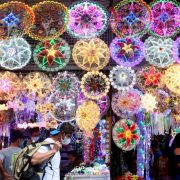History from advertisements

Benjamin Franklin is quoted to have said: “In this world, nothing can be said to be certain, except death and taxes.” If he lived in Metro Manila today he would have added traffic to the list. With online shopping and courier service readily available I wouldn’t dive into a mall these days to shop. Browsing online on Shopee and Lazada recently reminded me of advertisements in a 1907 anniversary issue of the Manila Bulletin in 1907 that showed a world both similar and different from ours. All good shops were in Manila, and that did not mean Spanish Manila inside the walls of Intramuros but outside the walls in Escolta, Binondo, Quiapo, etc.
If we have vaping today, they had smoking in 1907. Ordinary people smoked cigarettes. These came in hundreds of local brands rolled by hand in Binondo and Pampanga based on the colorful packaging. “Men of Superior Judgement” however, were shown in tuxedos and white ties endorsing Germinal Cigars. Daily output from this company was pegged at three million cigarettes and 100,000 cigars in 1907. Alhambra was another cigar and cigarette company that produced cigars in different shapes called Divinos, Imperiales, Perfectos, Panetelas, Regalia, Republicanos, and even Reina Victoria Extra. I presume Marines and High Life were marketed to Americans or English-speaking clients. If Germinal was for “men of superior judgement,” Alhambra products were for the “educated smoker.” Their operation was smaller where 30 machines worked night and day to produce 40,000 cigarettes a month.
Walter E. Olsen Cigar and Tobacco Merchants had two outlets: Kiosko Habanero on 27 Escolta and Kiosko Rizal further down at 168-170 Escolta. They marketed boxes of La Flor de Rizal cigars endorsed by no less than the national hero and the tagline “The eloquence of its value is in the burning.” These Rizal cigars had different shapes under these names: Generals, Colonels, Majors, Captains, Lieutenants, Sergeants, Corporals, and Privates.
While we are on “sin products,” it was odd that only two beers were advertised: Pabst Milwaukee beer and San Miguel. The former was distributed by the firm Kuenzle & Streiff in Manila, Iloilo, Cebu, and Zamboanga. SMB took a dig at its imported competitor with the words: “The cork’s out! The bottle is open! Pour the amber tonic into the glass and you have a perfect mild stimulant. Brewed for the tropics. No Preservatives! No Headaches!”
Tobacco, sugar, and hemp were the major cash crops in the late 19th and early 20th century Philippines that produced fortunes and the now large heritage mansions in major cities. Coffee was another cash crop, but there was only one advertisement for it Clarke’s Mayon Coffee that even had an illustration of a smoking Mayon Volcano formed from coffee beans. Clarkes on Escolta was not only a place for coffee it also sold candy.
Another company was the Philippine Cold Stores Limited, located at the foot of the Suspension Bridge aka “Puente Colgante” [replaced by the Quezon Bridge in 1939] on Calle Echague. This storage was open from 5 a.m. to 6 p.m., the place to source imported cold storage meat, fish, game, butter, milk, fruits, jams etc. Remember, one of the first permanent structures built in the American colonial Philippines was the Insular Ice Plant in 1902. The Manila Ice Factory or Fabrica de Hielo de Manila on 233 Calle San Miguel produced 50 tons of ice daily and had a refrigerating capacity of 130 tons. Only distilled water was used:
“…this crystalline ice can be mixed directly with water. The most eminent hygienists have repeatedly said that nothing in hot climes keeps the functions of the stomach in as good order as ice water. The civilization of a country is measured by the quantity of ice consumed, of soap used, and of flowers cultivated.” Eh di wow!
There was an advertisement for Meralco that was originally the Manila Electric Railway and Light Company. Aside from electricity, it also ran a transport system in the city while many people were still using candles, oil, and kerosene lamps for lighting. Meralco advertised “Power Lighting. Clean, Economical. Indispensable. Reliable. No smoke. No heat. No smell, Steady light. Won’t blow out. Low Rates.” This made me smile because these days we get shocked by our Meralco bill and while they advertised “No Blow Out” in 1907, we have “Brown Out” a century later.
The nostalgia for fountain pens and manual typewriters these days reminds me of many of my freshman students who will complain about a pen-and-paper essay test. Most of my students have penmanship worse than mine, and some of them have difficulty reading cursive. The Leon J. Lambert Company on 70 Calle David sold fountain pens. The endorser was a certain Bill Nye, not today’s science guy but someone who claimed that with a fountain pen, “I have been able to noticeably improve my spelling and also my standing among Christian people.” Now that is false advertising at its finest.
The Manila Bulletin is an English newspaper and I will have to dig up Spanish and Tagalog periodicals to compare and contrast the quality, quantity, and illustrations of their advertisements to reconstruct the past.
—————–
Comments are welcome at aocampo@ateneo.edu
Ambeth is a Public Historian whose research covers 19th century Philippines: its art, culture, and the people who figure in the birth of the nation. Professor and former Chair, Department of History, Ateneo de Manila University, he writes a widely-read editorial page column for the Philippine Daily Inquirer, and has published over 30 books—the most recent being: Martial Law: Looking Back 15 (Anvil, 2021) and Yaman: History and Heritage in Philippine Money (Bangko Sentral ng Pilipinas, 2021).


















